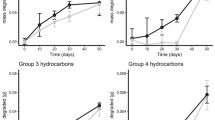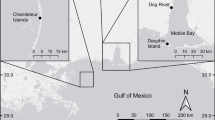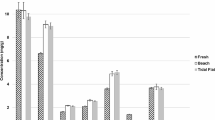Abstract
The expected increase in offshore oil exploration and production in the Arctic may lead to crude oil spills along arctic shorelines. To evaluate the potential effectiveness of bioremediation to treat such spills, oil spill bioremediation in arctic sediments was simulated in laboratory microcosms containing beach sediments from Barrow (Alaska), spiked with North Slope Crude, and incubated at varying temperatures and salinities. Biodegradation was measured via respiration rates (CO2 production); volatilization was quantified by gas chromatography/mass spectrophotometry (GC/MS) analysis of hydrocarbons sorbed to activated carbon, and hydrocarbons remaining in the sediment were quantified by GC/flame ionization detector (FID). Higher temperature leads to increased biodegradation by naturally occurring microorganisms, while the release of volatile organic compounds was similar at both temperatures. Increased salinity had a small positive impact on crude oil removal. At higher crude oil dosages, volatilization increased, however CO2 production did not. While only a small percentage of crude oil was completely biodegraded, a larger percentage was volatilized within 6–9 weeks.




Similar content being viewed by others
References
ADEC (2002a) Method AK 102 for determination of diesel range organics version 4/08/02. Alaska Department of Environmental Conservation
ADEC (2002b) Method AK 103 for determination of residual range organics version 4/08/02. Alaska Department of Environmental Conservation
Aislabie J, Saul DJ, Foght JM (2006) Bioremediation of hydrocarbon-contaminated polar soils. Extremophiles 10(3):171–179
Brakstad OG, Bonaunet K (2006) Biodegradation of petroleum hydrocarbons in seawater at low temperatures (0–5°C) and bacterial communities associated with degradation. Biodegradation 17(1):71–82
Cunningham CR (2004) Biodegradation Rates of Weathered Hydrocarbons in Controlled Laboratory Microcosms and Soil Columns Simulating Natural Attenuation Field Conditions, Thesis, California Polytechnic State University
Díaz MP, Boyd KG, Grigson SJ, Burgess JG (2002) Biodegradation of crude oil across a wide range of salinities by an extremely halotolerant bacterial consortium MPD‐M, immobilized onto polypropylene fibers. Biotechnol Bioeng 79(2):145–153
Fernández-Álvarez P, Vila J, Garrido-Fernández J, Grifoll M, Lema J (2006) Trials of bioremediation on a beach affected by the heavy oil spill of the Prestige. J Hazard Mater 137(3):1523–1531
Gibb A, Chu A, Wong RCK, Goodman RH (2001) Bioremediation kinetics of crude oil at 5 C. J Environ Eng 127(9):818–824
Horel A, Schiewer S (2009) Investigation of the physical and chemical parameters affecting biodegradation of diesel and synthetic diesel fuel contaminating Alaskan soils. Cold Regions Sci Technol 58:113–119
Horel A, Schiewer S (2011) Influence of constant and fluctuating temperature on biodegradation rates of fish biodiesel blends contaminating Alaskan sand. Chemosphere 83(5):652–660
Horel A, Schiewer S, Misra D (2015) Effect of concentration gradients on biodegradation in bench scale sand columns with HYDRUS modeling of hydrocarbon transport and degradation. Environ Sci Pollut Res 22:13251–13263. doi:10.1007/s11356-015-4576-6
León N, Infante C, Arias M, Márquez M, Gorrín A, McMillen SJ, Smart DR (1998) Biodegradability of Venezuelan crude oils. SPE International Conference on Health Safety and Environment in Oil and Gas Exploration and Production 48921
Margesin R (2000) Potential of cold-adapted microorganisms for bioremediation of oil-polluted alpine soils. Int Biodeter Biodegr 46(1):3–10
Minai-Tehrani D, Minoui S, Herfatmanesh A (2009) Effect of salinity on biodegradation of polycyclic aromatic hydrocarbons (PAHs) of heavy crude oil in soil. Bull Environ Contam Toxicol 82(2):179–184
Prince RC, Bare RE, Garrett RM, Grossman MJ, Haith CE, Keim LG, Kenneth L, Holtoms GJ, Lambert P, Sergy GA, Owens EH, Gue Neite CC (2003) Bioremediation of stranded oil on an arctic shoreline. Spill Sci Technol Bulletin 8(3):303–312
Rice SD, Short JW, Carls MG, Moles A, Spies RB (2007) “Chapter 5 – The Exxon Valdez Oil Spill”, in Long-term Ecological Change in the Northern Gulf of Alaska, Elsevier B.V.: 419–520
Schiewer S, Horel A (2016) Determination of microbial growth phases for hydrocarbon biodegradation in sub-arctic sandy soils. In preparation.
Schiewer S, Niemeyer T (2006) Soil heating and optimized nutrient addition for accelerating bioremediation in cold climates. Polar Record 42(220):23–31
Thavasi R, Jayalakshmi S, Balasubramanian T, Banat IM (2007) Effect of salinity, temperature, pH and crude oil concentration on biodegradation of crude oil by Pseudomonas aeruginosa. J Biol Environ Sci 1(2):51–57
Wrabel ML, Peckol P (2000) Effects of bioremediation on toxicity and chemical composition of no. 2 fuel oil: growth responses of the brown alga Fucus vesiculosus. Mar Pollut Bull 40(2):135–139
Yang SZ, ** HJ, Wei Z, He RX, Ji YJ, Li XM, Yu SP (2009) Bioremediation of oil spills in cold environments: a review. Pedosphere 19(3):371–381
Acknowledgments
Funding was provided by the University of Alaska Fairbanks Water and Environmental Research Center and a grant by the Bureau of Ocean Energy Management. The views and conclusions contained in this document are those of the authors and should not be interpreted as representing the opinions or policies of the US government. Thanks go to Flint Hills for providing the crude oil, Shane Billings for help with chemical analyses, as well as Anna Iverson and Andy Chamberlain for collecting sediment samples.
Author information
Authors and Affiliations
Corresponding author
Additional information
Responsible editor: Roland Kallenborn
Electronic supplementary material
Below is the link to the electronic supplementary material.
ESM 1
The supporting information includes a figure showing the experimental setup, as well as preliminary measurements of hydrocarbon degrader numbers. (DOCX 1598 kb)
Rights and permissions
About this article
Cite this article
Sharma, P., Schiewer, S. Assessment of crude oil biodegradation in arctic seashore sediments: effects of temperature, salinity, and crude oil concentration. Environ Sci Pollut Res 23, 14881–14888 (2016). https://doi.org/10.1007/s11356-016-6601-9
Received:
Accepted:
Published:
Issue Date:
DOI: https://doi.org/10.1007/s11356-016-6601-9




